Rong Yin
What Really Matters for Robust Multi-Sensor HD Map Construction?
Jul 02, 2025Abstract:High-definition (HD) map construction methods are crucial for providing precise and comprehensive static environmental information, which is essential for autonomous driving systems. While Camera-LiDAR fusion techniques have shown promising results by integrating data from both modalities, existing approaches primarily focus on improving model accuracy and often neglect the robustness of perception models, which is a critical aspect for real-world applications. In this paper, we explore strategies to enhance the robustness of multi-modal fusion methods for HD map construction while maintaining high accuracy. We propose three key components: data augmentation, a novel multi-modal fusion module, and a modality dropout training strategy. These components are evaluated on a challenging dataset containing 10 days of NuScenes data. Our experimental results demonstrate that our proposed methods significantly enhance the robustness of baseline methods. Furthermore, our approach achieves state-of-the-art performance on the clean validation set of the NuScenes dataset. Our findings provide valuable insights for developing more robust and reliable HD map construction models, advancing their applicability in real-world autonomous driving scenarios. Project website: https://robomap-123.github.io.
SafeMap: Robust HD Map Construction from Incomplete Observations
Jul 01, 2025Abstract:Robust high-definition (HD) map construction is vital for autonomous driving, yet existing methods often struggle with incomplete multi-view camera data. This paper presents SafeMap, a novel framework specifically designed to secure accuracy even when certain camera views are missing. SafeMap integrates two key components: the Gaussian-based Perspective View Reconstruction (G-PVR) module and the Distillation-based Bird's-Eye-View (BEV) Correction (D-BEVC) module. G-PVR leverages prior knowledge of view importance to dynamically prioritize the most informative regions based on the relationships among available camera views. Furthermore, D-BEVC utilizes panoramic BEV features to correct the BEV representations derived from incomplete observations. Together, these components facilitate the end-to-end map reconstruction and robust HD map generation. SafeMap is easy to implement and integrates seamlessly into existing systems, offering a plug-and-play solution for enhanced robustness. Experimental results demonstrate that SafeMap significantly outperforms previous methods in both complete and incomplete scenarios, highlighting its superior performance and reliability.
Multi-Modal Molecular Representation Learning via Structure Awareness
May 09, 2025Abstract:Accurate extraction of molecular representations is a critical step in the drug discovery process. In recent years, significant progress has been made in molecular representation learning methods, among which multi-modal molecular representation methods based on images, and 2D/3D topologies have become increasingly mainstream. However, existing these multi-modal approaches often directly fuse information from different modalities, overlooking the potential of intermodal interactions and failing to adequately capture the complex higher-order relationships and invariant features between molecules. To overcome these challenges, we propose a structure-awareness-based multi-modal self-supervised molecular representation pre-training framework (MMSA) designed to enhance molecular graph representations by leveraging invariant knowledge between molecules. The framework consists of two main modules: the multi-modal molecular representation learning module and the structure-awareness module. The multi-modal molecular representation learning module collaboratively processes information from different modalities of the same molecule to overcome intermodal differences and generate a unified molecular embedding. Subsequently, the structure-awareness module enhances the molecular representation by constructing a hypergraph structure to model higher-order correlations between molecules. This module also introduces a memory mechanism for storing typical molecular representations, aligning them with memory anchors in the memory bank to integrate invariant knowledge, thereby improving the model generalization ability. Extensive experiments have demonstrated the effectiveness of MMSA, which achieves state-of-the-art performance on the MoleculeNet benchmark, with average ROC-AUC improvements ranging from 1.8% to 9.6% over baseline methods.
Evaluating the Feasibility and Accuracy of Large Language Models for Medical History-Taking in Obstetrics and Gynecology
Mar 31, 2025Abstract:Effective physician-patient communications in pre-diagnostic environments, and most specifically in complex and sensitive medical areas such as infertility, are critical but consume a lot of time and, therefore, cause clinic workflows to become inefficient. Recent advancements in Large Language Models (LLMs) offer a potential solution for automating conversational medical history-taking and improving diagnostic accuracy. This study evaluates the feasibility and performance of LLMs in those tasks for infertility cases. An AI-driven conversational system was developed to simulate physician-patient interactions with ChatGPT-4o and ChatGPT-4o-mini. A total of 70 real-world infertility cases were processed, generating 420 diagnostic histories. Model performance was assessed using F1 score, Differential Diagnosis (DDs) Accuracy, and Accuracy of Infertility Type Judgment (ITJ). ChatGPT-4o-mini outperformed ChatGPT-4o in information extraction accuracy (F1 score: 0.9258 vs. 0.9029, p = 0.045, d = 0.244) and demonstrated higher completeness in medical history-taking (97.58% vs. 77.11%), suggesting that ChatGPT-4o-mini is more effective in extracting detailed patient information, which is critical for improving diagnostic accuracy. In contrast, ChatGPT-4o performed slightly better in differential diagnosis accuracy (2.0524 vs. 2.0048, p > 0.05). ITJ accuracy was higher in ChatGPT-4o-mini (0.6476 vs. 0.5905) but with lower consistency (Cronbach's $\alpha$ = 0.562), suggesting variability in classification reliability. Both models demonstrated strong feasibility in automating infertility history-taking, with ChatGPT-4o-mini excelling in completeness and extraction accuracy. In future studies, expert validation for accuracy and dependability in a clinical setting, AI model fine-tuning, and larger datasets with a mix of cases of infertility have to be prioritized.
AS-GCL: Asymmetric Spectral Augmentation on Graph Contrastive Learning
Feb 19, 2025Abstract:Graph Contrastive Learning (GCL) has emerged as the foremost approach for self-supervised learning on graph-structured data. GCL reduces reliance on labeled data by learning robust representations from various augmented views. However, existing GCL methods typically depend on consistent stochastic augmentations, which overlook their impact on the intrinsic structure of the spectral domain, thereby limiting the model's ability to generalize effectively. To address these limitations, we propose a novel paradigm called AS-GCL that incorporates asymmetric spectral augmentation for graph contrastive learning. A typical GCL framework consists of three key components: graph data augmentation, view encoding, and contrastive loss. Our method introduces significant enhancements to each of these components. Specifically, for data augmentation, we apply spectral-based augmentation to minimize spectral variations, strengthen structural invariance, and reduce noise. With respect to encoding, we employ parameter-sharing encoders with distinct diffusion operators to generate diverse, noise-resistant graph views. For contrastive loss, we introduce an upper-bound loss function that promotes generalization by maintaining a balanced distribution of intra- and inter-class distance. To our knowledge, we are the first to encode augmentation views of the spectral domain using asymmetric encoders. Extensive experiments on eight benchmark datasets across various node-level tasks demonstrate the advantages of the proposed method.
MapFusion: A Novel BEV Feature Fusion Network for Multi-modal Map Construction
Feb 05, 2025Abstract:Map construction task plays a vital role in providing precise and comprehensive static environmental information essential for autonomous driving systems. Primary sensors include cameras and LiDAR, with configurations varying between camera-only, LiDAR-only, or camera-LiDAR fusion, based on cost-performance considerations. While fusion-based methods typically perform best, existing approaches often neglect modality interaction and rely on simple fusion strategies, which suffer from the problems of misalignment and information loss. To address these issues, we propose MapFusion, a novel multi-modal Bird's-Eye View (BEV) feature fusion method for map construction. Specifically, to solve the semantic misalignment problem between camera and LiDAR BEV features, we introduce the Cross-modal Interaction Transform (CIT) module, enabling interaction between two BEV feature spaces and enhancing feature representation through a self-attention mechanism. Additionally, we propose an effective Dual Dynamic Fusion (DDF) module to adaptively select valuable information from different modalities, which can take full advantage of the inherent information between different modalities. Moreover, MapFusion is designed to be simple and plug-and-play, easily integrated into existing pipelines. We evaluate MapFusion on two map construction tasks, including High-definition (HD) map and BEV map segmentation, to show its versatility and effectiveness. Compared with the state-of-the-art methods, MapFusion achieves 3.6% and 6.2% absolute improvements on the HD map construction and BEV map segmentation tasks on the nuScenes dataset, respectively, demonstrating the superiority of our approach.
MSC-Bench: Benchmarking and Analyzing Multi-Sensor Corruption for Driving Perception
Jan 02, 2025



Abstract:Multi-sensor fusion models play a crucial role in autonomous driving perception, particularly in tasks like 3D object detection and HD map construction. These models provide essential and comprehensive static environmental information for autonomous driving systems. While camera-LiDAR fusion methods have shown promising results by integrating data from both modalities, they often depend on complete sensor inputs. This reliance can lead to low robustness and potential failures when sensors are corrupted or missing, raising significant safety concerns. To tackle this challenge, we introduce the Multi-Sensor Corruption Benchmark (MSC-Bench), the first comprehensive benchmark aimed at evaluating the robustness of multi-sensor autonomous driving perception models against various sensor corruptions. Our benchmark includes 16 combinations of corruption types that disrupt both camera and LiDAR inputs, either individually or concurrently. Extensive evaluations of six 3D object detection models and four HD map construction models reveal substantial performance degradation under adverse weather conditions and sensor failures, underscoring critical safety issues. The benchmark toolkit and affiliated code and model checkpoints have been made publicly accessible.
Communication-Efficient Personalized Federal Graph Learning via Low-Rank Decomposition
Dec 18, 2024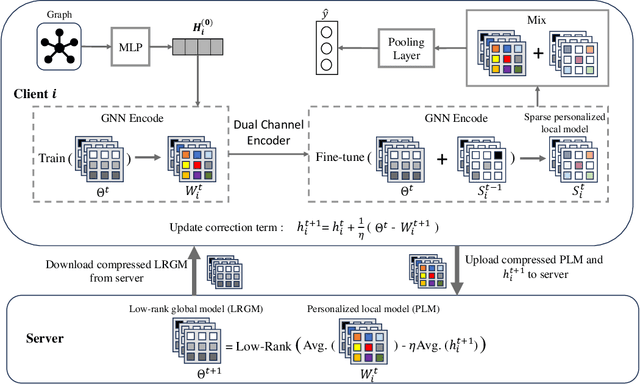
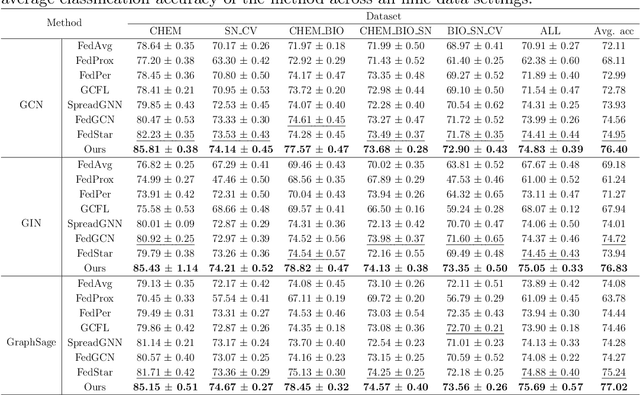
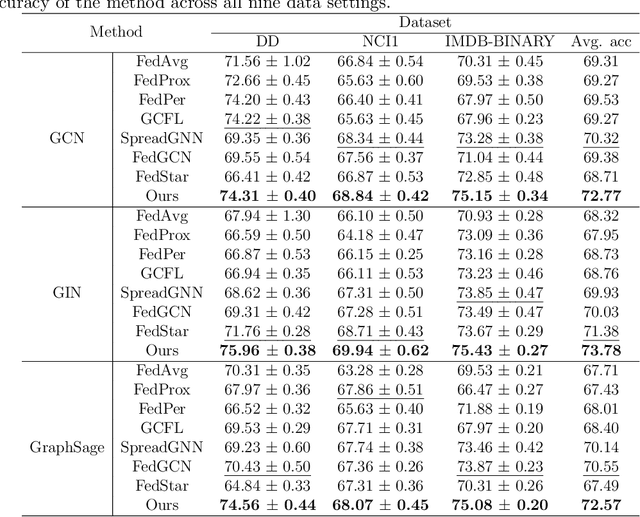

Abstract:Federated graph learning (FGL) has gained significant attention for enabling heterogeneous clients to process their private graph data locally while interacting with a centralized server, thus maintaining privacy. However, graph data on clients are typically non-IID, posing a challenge for a single model to perform well across all clients. Another major bottleneck of FGL is the high cost of communication. To address these challenges, we propose a communication-efficient personalized federated graph learning algorithm, CEFGL. Our method decomposes the model parameters into low-rank generic and sparse private models. We employ a dual-channel encoder to learn sparse local knowledge in a personalized manner and low-rank global knowledge in a shared manner. Additionally, we perform multiple local stochastic gradient descent iterations between communication phases and integrate efficient compression techniques into the algorithm. The advantage of CEFGL lies in its ability to capture common and individual knowledge more precisely. By utilizing low-rank and sparse parameters along with compression techniques, CEFGL significantly reduces communication complexity. Extensive experiments demonstrate that our method achieves optimal classification accuracy in a variety of heterogeneous environments across sixteen datasets. Specifically, compared to the state-of-the-art method FedStar, the proposed method (with GIN as the base model) improves accuracy by 5.64\% on cross-datasets setting CHEM, reduces communication bits by a factor of 18.58, and reduces the communication time by a factor of 1.65.
FTF-ER: Feature-Topology Fusion-Based Experience Replay Method for Continual Graph Learning
Jul 28, 2024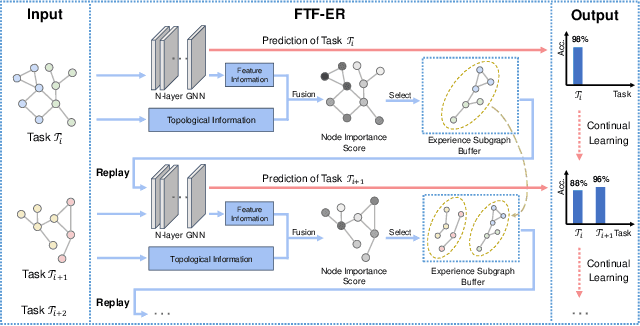
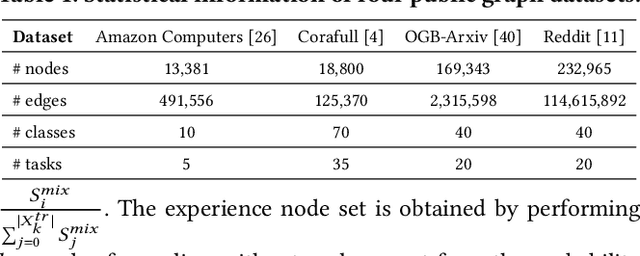
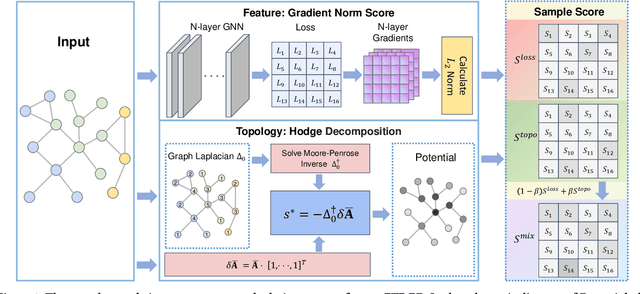
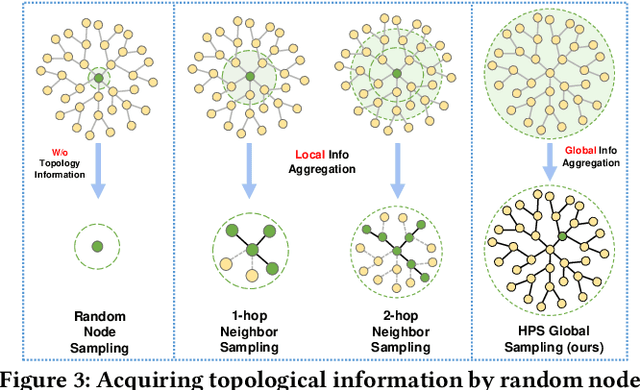
Abstract:Continual graph learning (CGL) is an important and challenging task that aims to extend static GNNs to dynamic task flow scenarios. As one of the mainstream CGL methods, the experience replay (ER) method receives widespread attention due to its superior performance. However, existing ER methods focus on identifying samples by feature significance or topological relevance, which limits their utilization of comprehensive graph data. In addition, the topology-based ER methods only consider local topological information and add neighboring nodes to the buffer, which ignores the global topological information and increases memory overhead. To bridge these gaps, we propose a novel method called Feature-Topology Fusion-based Experience Replay (FTF-ER) to effectively mitigate the catastrophic forgetting issue with enhanced efficiency. Specifically, from an overall perspective to maximize the utilization of the entire graph data, we propose a highly complementary approach including both feature and global topological information, which can significantly improve the effectiveness of the sampled nodes. Moreover, to further utilize global topological information, we propose Hodge Potential Score (HPS) as a novel module to calculate the topological importance of nodes. HPS derives a global node ranking via Hodge decomposition on graphs, providing more accurate global topological information compared to neighbor sampling. By excluding neighbor sampling, HPS significantly reduces buffer storage costs for acquiring topological information and simultaneously decreases training time. Compared with state-of-the-art methods, FTF-ER achieves a significant improvement of 3.6% in AA and 7.1% in AF on the OGB-Arxiv dataset, demonstrating its superior performance in the class-incremental learning setting.
MapDistill: Boosting Efficient Camera-based HD Map Construction via Camera-LiDAR Fusion Model Distillation
Jul 16, 2024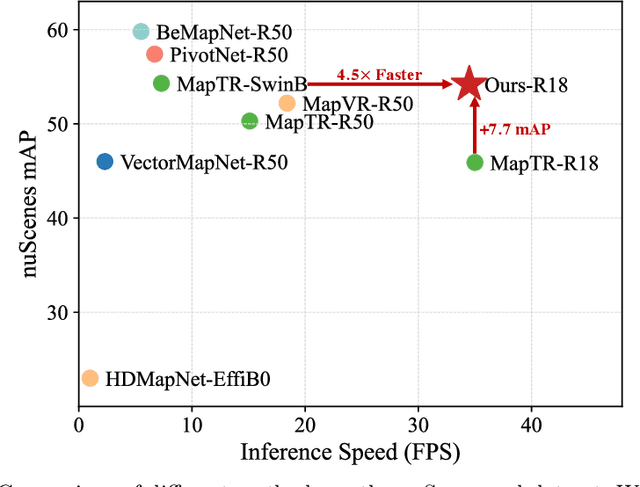
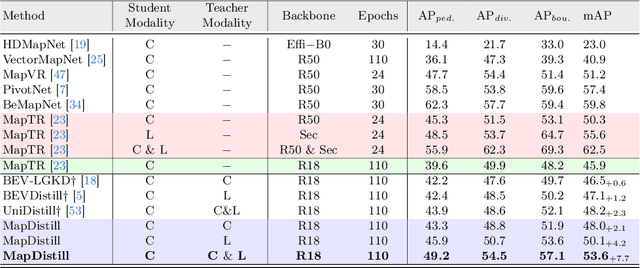
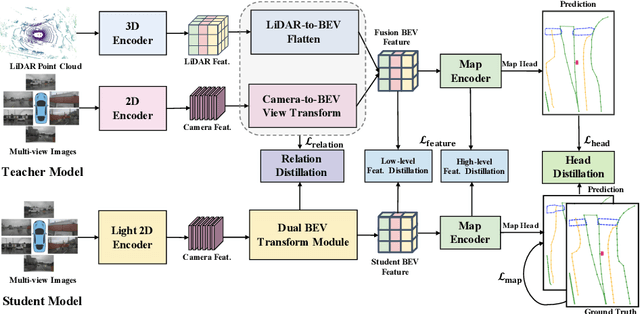
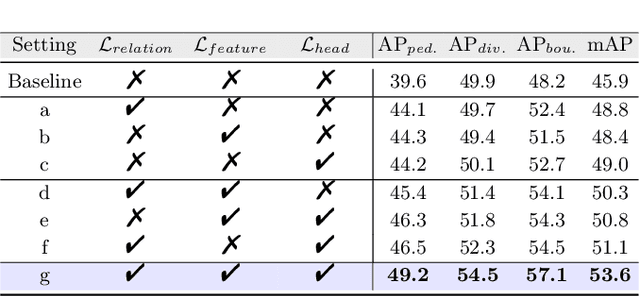
Abstract:Online high-definition (HD) map construction is an important and challenging task in autonomous driving. Recently, there has been a growing interest in cost-effective multi-view camera-based methods without relying on other sensors like LiDAR. However, these methods suffer from a lack of explicit depth information, necessitating the use of large models to achieve satisfactory performance. To address this, we employ the Knowledge Distillation (KD) idea for efficient HD map construction for the first time and introduce a novel KD-based approach called MapDistill to transfer knowledge from a high-performance camera-LiDAR fusion model to a lightweight camera-only model. Specifically, we adopt the teacher-student architecture, i.e., a camera-LiDAR fusion model as the teacher and a lightweight camera model as the student, and devise a dual BEV transform module to facilitate cross-modal knowledge distillation while maintaining cost-effective camera-only deployment. Additionally, we present a comprehensive distillation scheme encompassing cross-modal relation distillation, dual-level feature distillation, and map head distillation. This approach alleviates knowledge transfer challenges between modalities, enabling the student model to learn improved feature representations for HD map construction. Experimental results on the challenging nuScenes dataset demonstrate the effectiveness of MapDistill, surpassing existing competitors by over 7.7 mAP or 4.5X speedup.
 Add to Chrome
Add to Chrome Add to Firefox
Add to Firefox Add to Edge
Add to Edge